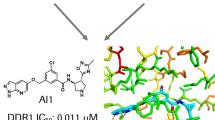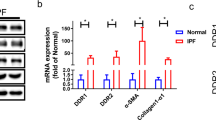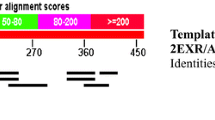Abstract
Discoidin domain receptor 1 (DDR1) (EC Number 2.7.10.1) has recently been considered as a promising therapeutic target for idiopathic pulmonary fibrosis (IPF). However, none of the currently discovered DDR1 inhibitors have been included in clinical studies due to low target specificity or druggability limitations, necessitating various approaches to develop novel DDR1 inhibitors. In this study, to assure target specificity, a docking assessment of the DDR1 crystal structures was undertaken to find the well-differentiated crystal structure, and 4CKR was identified among many crystal structures. Then, using the best pharmacophore model and molecular docking, virtual screening of the ChEMBL database was done, and five potential molecules were identified as promising inhibitors of DDR1. Subsequently, all hit compound complex systems were validated using molecular dynamics simulations and MM/PBSA methods to assess the stability of the system after ligand binding to DDR1. Based on molecular dynamics simulations and hydrogen-bonding occupancy analysis, the DDR1-Cpd2, DDR1-Cpd17, and DDR1-Cpd18 complex systems exhibited superior stability compared to the DDR1-Cpd1 and DDR-Cpd33 complex systems. Meanwhile, when targeting DDR1, the descending order of the five hit molecules’ binding free energies was Cpd17 (− 145.820 kJ/mol) > Cpd2 (− 131.818 kJ/mol) > Cpd18 (− 130.692 kJ/mol) > Cpd33 (− 129.175 kJ/mol) > Cpd1 (− 126.103 kJ/mol). Among them, Cpd2, Cpd17, and Cpd18 showed improved binding characteristics, indicating that they may be potential DDR1 inhibitors. In this research, we developed a high-hit rate, effective screening method that serves as a theoretical guide for finding DDR1 inhibitors for the development of IPF therapeutics.
Graphical abstract











Similar content being viewed by others
References
Dong Y, Tang BX, Wang Q, Zhou LW, Li C, Zhang X, Sun DD, Sun X, Zhang XM, Xiong B, Li J, Shi H, Chen DQ, Zang Y (2022) Discovery of a novel DDRs kinase inhibitor XBLJ-13 for the treatment of idiopathic pulmonary fibrosis. Acta Pharmacol Sin 43(7):1769–1779. https://doi.org/10.1038/s41401-021-00808-z
Tao J, Zhang M, Wen Z, Wang B, Zhang L, Ou Y, Tang X, Yu X, Jiang Q (2018) Inhibition of EP300 and DDR1 synergistically alleviates pulmonary fibrosis in vitro and in vivo. Biomed Pharmacother 106:1727–1733. https://doi.org/10.1016/j.biopha.2018.07.132
Avivi-Green C, Singal M, Vogel WF (2006) Discoidin domain receptor 1-deficient mice are resistant to bleomycin-induced lung fibrosis. Am J Respir Crit Care Med 174(4):420–427. https://doi.org/10.1164/rccm.200603-333OC
Glass DS, Grossfeld D, Renna HA, Agarwala P, Spiegler P, Kasselman LJ, Glass AD, DeLeon J, Reiss AB (2020) Idiopathic pulmonary fibrosis: molecular mechanisms and potential treatment approaches. Respir Investig 58(5):320–335. https://doi.org/10.1016/j.resinv.2020.04.002
Rackov G, Hernández-Jiménez E, Shokri R, Carmona-Rodríguez L, Mañes S, Álvarez-Mon M, López-Collazo E, Martínez-A C, Balomenos D (2016) p21 mediates macrophage reprogramming through regulation of p50–p50 NF-κB and IFN-β. J Clin Investig 126(8):3089–3103. https://doi.org/10.1172/JCI83404
Valiathan RR, Marco M, Leitinger B, Kleer CG, Fridman R (2012) Discoidin domain receptor tyrosine kinases: new players in cancer progression. Cancer Metastasis Rev 31(1–2):295–321. https://doi.org/10.1007/s10555-012-9346-z
Kothiwale S, Borza CM, Lowe EW Jr, Pozzi A, Meiler J (2015) Discoidin domain receptor 1 (DDR1) kinase as target for structure-based drug discovery. Drug Discov Today 20(2):255–261. https://doi.org/10.1016/j.drudis.2014.09.025
Leitinger B (2014) Discoidin domain receptor functions in physiological and pathological conditions. Int Rev Cell Mol Biol 310:39–87. https://doi.org/10.1016/B978-0-12-800180-6.00002-5
Yoshida D, Teramoto A (2007) Enhancement of pituitary adenoma cell invasion and adhesion is mediated by discoidin domain receptor-1. J Neurooncol 82(1):29–40. https://doi.org/10.1007/s11060-006-9246-6
Vogel WF, Abdulhussein R, Ford CE (2006) Sensing extracellular matrix: an update on discoidin domain receptor function. Cell Signal 18(8):1108–1116. https://doi.org/10.1016/j.cellsig.2006.02.012
Borza CM, Pozzi A (2014) Discoidin domain receptors in disease. Matrix Biol 34:185–192. https://doi.org/10.1016/j.matbio.2013.12.002
Ju GX, Hu YB, Du MR, Jiang JL (2015) Discoidin domain receptors (DDRs): potential implications in atherosclerosis. Eur J Pharmacol 751:28–33. https://doi.org/10.1016/j.ejphar.2015.01.033
Sakamoto O, Suga M, Suda T, Ando M (2001) Expression of discoidin domain receptor 1 tyrosine kinase on the human bronchial epithelium. Eur Respir J 17(5):969–974. https://doi.org/10.1183/09031936.01.17509690
Canning P, Tan L, Chu K, Lee SW, Gray NS, Bullock AN (2014) Structural mechanisms determining inhibition of the collagen receptor DDR1 by selective and multi-targeted type II kinase inhibitors. J Mol Biol 426(13):2457–2470. https://doi.org/10.1016/j.jmb.2014.04.014
Hanson SM, Georghiou G, Thakur MK, Miller WT, Rest JS, Chodera JD, Seeliger MA (2019) What makes a kinase promiscuous for inhibitors? Cell Chem Biol 26(3):390-399.e5. https://doi.org/10.1016/j.chembiol.2018.11.005
Kim HG, Tan L, Weisberg EL, Liu F, Canning P, Choi HG, Ezell SA, Wu H, Zhao Z, Wang J, Mandinova A, Griffin JD, Bullock AN, Liu Q, Lee SW, Gray NS (2013) Discovery of a potent and selective DDR1 receptor tyrosine kinase inhibitor. ACS Chem Biol 8(10):2145–2150. https://doi.org/10.1021/cb400430t
Wang Z, Bian H, Bartual SG, Du W, Luo J, Zhao H, Zhang S, Mo C, Zhou Y, Xu Y, Tu Z, Ren X, Lu X, Brekken RA, Yao L, Bullock AN, Su J, Ding K (2016) Structure-based design of tetrahydroisoquinoline-7-carboxamides as selective Discoidin Domain Receptor 1 (DDR1) inhibitors. J Med Chem 59(12):5911–5916. https://doi.org/10.1021/acs.jmedchem.6b00140
Vanajothi R, Hemamalini V, Jeyakanthan J, Premkumar K (2020) Ligand-based pharmacophore mapping and virtual screening for identification of potential discoidin domain receptor 1 inhibitors. J Biomol Struct Dyn 38(9):2800–2808. https://doi.org/10.1080/07391102.2019.1640132
Nada H, Lee K, Gotina L, Pae AN, Elkamhawy A (2022) Identification of novel discoidin domain receptor 1 (DDR1) inhibitors using E-pharmacophore modeling, structure-based virtual screening, molecular dynamics simulation and MM-GBSA approaches. Comput Biol Med 142:105217. https://doi.org/10.1016/j.compbiomed.2022.105217
Zhavoronkov A, Ivanenkov YA, Aliper A, Veselov MS, Aladinskiy VA, Aladinskaya AV, Terentiev VA, Polykovskiy DA, Kuznetsov MD, Asadulaev A, Volkov Y, Zholus A, Shayakhmetov RR, Zhebrak A, Minaeva LI, Zagribelnyy BA, Lee LH, Soll R, Madge D, Xing L et al (2019) Deep learning enables rapid identification of potent DDR1 kinase inhibitors. Nat Biotechnol 37(9):1038–1040. https://doi.org/10.1038/s41587-019-0224-x
Yoshimori A, Asawa Y, Kawasaki E, Tasaka T, Matsuda S, Sekikawa T, Tanabe S, Neya M, Natsugari H, Kanai C (2021) Design and synthesis of DDR1 inhibitors with a desired pharmacophore using deep generative models. ChemMedChem 16(6):955–958. https://doi.org/10.1002/cmdc.202000786
Tan X, Li C, Yang R, Zhao S, Li F, Li X, Chen L, Wan X, Liu X, Yang T, Tong X, Xu T, Cui R, Jiang H, Zhang S, Liu H, Zheng M (2022) Discovery of pyrazolo[3,4-d] pyridazinone derivatives as selective DDR1 inhibitors via deep learning based design, synthesis, and biological evaluation. J Med Chem 65(1):103–119. https://doi.org/10.1021/acs.jmedchem.1c01205
Ge H, Peng L, Sun Z, Liu H, Shen Y, Yao X (2022) Discovery of novel HPK1 inhibitors through structure-based virtual screening. Front Pharmacol 13:850855. https://doi.org/10.3389/fphar.2022.850855
Murray CW, Berdini V, Buck IM, Carr ME, Cleasby A, Coyle JE, Curry JE, Day JE, Day PJ, Hearn K, Iqbal A, Lee LY, Martins V, Mortenson PN, Munck JM, Page LW, Patel S, Roomans S, Smith K, Tamanini E et al (2015) Fragment-based discovery of potent and selective DDR1/2 inhibitors. ACS Med Chem Lett 6(7):798–803. https://doi.org/10.1021/acsmedchemlett.5b00143
Richter H, Satz AL, Bedoucha M, Buettelmann B, Petersen AC, Harmeier A, Hermosilla R, Hochstrasser R, Burger D, Gsell B, Gasser R, Huber S, Hug MN, Kocer B, Kuhn B, Ritter M, Rudolph MG, Weibel F, Molina-David J, Kim JJ et al (2019) DNA-encoded library-derived DDR1 inhibitor prevents fibrosis and renal function loss in a genetic mouse model of alport syndrome. ACS Chem Biol 14(1):37–49. https://doi.org/10.1021/acschembio.8b00866
Wang Z, Zhang Y, Pinkas DM, Fox AE, Luo J, Huang H, Cui S, Xiang Q, Xu T, Xun Q, Zhu D, Tu Z, Ren X, Brekken RA, Bullock AN, Liang G, Ding K, Lu X (2018) Design, synthesis, and biological evaluation of 3-(imidazo[1,2-a] pyrazin-3-ylethynyl)-4-isopropyl-n-(3-((4-methylpiperazin-1-yl) methyl)-5-(trifluoromethyl) phenyl) benzamide as a dual inhibitor of discoidin domain receptors 1 and 2. J Med Chem 61(17):7977–7990. https://doi.org/10.1021/acs.jmedchem.8b01045
Zhu D, Huang H, Pinkas DM, Luo J, Ganguly D, Fox AE, Arner E, Xiang Q, Tu ZC, Bullock AN, Brekken RA, Ding K, Lu X (2019) 2-Amino-2,3-dihydro-1H-indene-5-carboxamide-based discoidin domain receptor 1 (DDR1) inhibitors: design, synthesis, and in vivo antipancreatic cancer efficacy. J Med Chem 62(16):7431–7444. https://doi.org/10.1021/acs.jmedchem.9b00365
Berman HM, Westbrook J, Feng Z, Gilliland G, Bhat TN, Weissig H, Shindyalov IN, Bourne PE (2000) The protein data bank. Nucleic Acids Res 28:235–242
Elkamhawy A, Lu Q, Nada H, Woo J, Quan G, Lee K (2021) The journey of DDR1 and DDR2 kinase inhibitors as rising stars in the fight against cancer. Int J Mol Sci 22(12):6535. https://doi.org/10.3390/ijms22126535
Matada GSP, Das A, Dhiwar PS, Ghara A (2021) DDR1 and DDR2: a review on signaling pathway and small molecule inhibitors as an anticancer agent. Med Chem Res 30(3):535–551. https://doi.org/10.1007/s00044-020-02694-2
Mo C, Zhang Z, Li Y, Huang M, Zou J, Luo J, Tu ZC, Xu Y, Ren X, Ding K, Lu X (2020) Design and optimization of 3’-(Imidazo[1,2-a] pyrazin-3-yl)-[1,1’-biphenyl]-3-carboxamides as selective DDR1 inhibitors. ACS Med Chem Lett 11(3):379–384. https://doi.org/10.1021/acsmedchemlett.9b00495
Jeffries DE, Borza CM, Blobaum AL, Pozzi A, Lindsley CW (2019) Discovery of VU6015929: a selective discoidin domain receptor 1/2 (DDR1/2) inhibitor to explore the role of DDR1 in antifibrotic therapy. ACS Med Chem Lett 11(1):29–33. https://doi.org/10.1021/acsmedchemlett.9b00382
Dong R, Zhou X, Wang M, Li W, Zhang JY, Zheng X, Tang KX, Sun LP (2021) Discovery of 4-amino-1H-pyrazolo[3,4-d] pyrimidin derivatives as novel discoidin domain receptor 1 (DDR1) inhibitors. Bioorg Med Chem 29:115876. https://doi.org/10.1016/j.bmc.2020.115876
Liu L, Hussain M, Luo J, Duan A, Chen C, Tu Z, Zhang J (2017) Synthesis and biological evaluation of novel dasatinib analogues as potent DDR1 and DDR2 kinase inhibitors. Chem Biol Drug Des 89(3):420–427. https://doi.org/10.1111/cbdd.12863
Mysinger MM, Carchia M, Irwin JJ, Shoichet BK (2012) Directory of useful decoys, enhanced (DUD-E): better ligands and decoys for better benchmarking. J Med Chem 55(14):6582–6594. https://doi.org/10.1021/jm300687e
O’Boyle NM, Banck M, James CA, Morley C, Vandermeersch T, Hutchison GR (2011) Open Babel: an open chemical toolbox. J Cheminform 3:33. https://doi.org/10.1186/1758-2946-3-33
Trott O, Olson AJ (2010) AutoDock Vina: improving the speed and accuracy of docking with a new scoring function, efficient optimization, and multithreading. J Comput Chem 31(2):455–461. https://doi.org/10.1002/jcc.21334
Halgren TA, Murphy RB, Friesner RA, Beard HS, Frye LL, Pollard WT, Banks JL (2004) Glide: a new approach for rapid, accurate docking and scoring. 2. Enrichment factors in database screening. J Med Chem 47(7):1750–1759. https://doi.org/10.1021/jm030644s
Lipinski CA (2004) Lead- and drug-like compounds: the rule-of-five revolution. Drug Discov Today Technol 1(4):337–341. https://doi.org/10.1016/j.ddtec.2004.11.007
Zhang H, Zhang L, Gao C, Yu R, Kang C (2021) Pharmacophore screening, molecular docking, ADMET prediction and MD simulations for identification of ALK and MEK potential dual inhibitors. J Mol Struct 1245. https://doi.org/10.1016/j.molstruc.2021.131066
Daina A, Michielin O, Zoete V (2017) SwissADME: a free web tool to evaluate pharmacokinetics, drug-likeness and medicinal chemistry friendliness of small molecules. Sci Rep 7:42717. https://doi.org/10.1038/srep42717
Pires DE, Blundell TL, Ascher DB (2015) pkCSM: predicting small-molecule pharmacokinetic and toxicity properties using graph-based signatures. J Med Chem 58(9):4066–4072. https://doi.org/10.1021/acs.jmedchem.5b00104
Xiong G, Wu Z, Yi J, Fu L, Yang Z, Hsieh C, Yin M, Zeng X, Wu C, Lu A, Chen X, Hou T, Cao D (2021) ADMETlab 2.0: an integrated online platform for accurate and comprehensive predictions of ADMET properties. Nucleic Acids Res 49(W1):W5–W14. https://doi.org/10.1093/nar/gkab255
Banerjee P, Eckert AO, Schrey AK, Preissner R (2018) ProTox-II: a webserver for the prediction of toxicity of chemicals. Nucleic Acids Res 46(W1):W257–W263. https://doi.org/10.1093/nar/gky318
Van Der Spoel D, Lindahl E, Hess B, Groenhof G, Mark AE, Berendsen HJ (2005) GROMACS: fast, flexible, and free. J Comput Chem 26(16):1701–1718. https://doi.org/10.1002/jcc.20291
Huang J, Rauscher S, Nawrocki G, Ran T, Feig M, de Groot BL, Grubmüller H, MacKerell AD Jr (2017) CHARMM36m: an improved force field for folded and intrinsically disordered proteins. Nat Methods 14(1):71–73. https://doi.org/10.1038/nmeth.4067
Hanwell MD, Curtis DE, Lonie DC, Vandermeersch T, Zurek E, Hutchison GR (2012) Avogadro: an advanced semantic chemical editor, visualization, and analysis platform. J Cheminform 4(1):17. https://doi.org/10.1186/1758-2946-4-17
Vanommeslaeghe K, Hatcher E, Acharya C, Kundu S, Zhong S, Shim J, Darian E, Guvench O, Lopes P, Vorobyov I, Mackerell AD Jr (2010) CHARMM general force field: a force field for drug-like molecules compatible with the CHARMM all-atom additive biological force fields. J Comput Chem 31(4):671–690. https://doi.org/10.1002/jcc.21367
Gharaghani S, Khayamian T, Ebrahimi M (2013) Molecular dynamics simulation study and molecular docking descriptors in structure-based QSAR on acetylcholinesterase (AChE) inhibitors. SAR QSAR Environ Res 24(9):773–794. https://doi.org/10.1080/1062936X.2013.792877
Humphrey W, Dalke A, Schulten K (1996) VMD: visual molecular dynamics. J Mol Graph 14(1):33–28. https://doi.org/10.1016/0263-7855(96)00018-5
Tran QH, Nguyen QT, Vo NQ, Mai TT, Tran TT, Tran TD et al (2022) Structure-based 3D-Pharmacophore modeling to discover novel interleukin 6 inhibitors: an in silico screening, molecular dynamics simulations and binding free energy calculations. PLoS ONE 17(4):e0266632. https://doi.org/10.1371/journal.pone.0266632
Genheden S, Ryde U (2015) The MM/PBSA and MM/GBSA methods to estimate ligand-binding affinities. Expert Opin Drug Discov 10(5):449–461. https://doi.org/10.1517/17460441.2015.1032936
Valdés-Tresanco MS, Valdés-Tresanco ME, Valiente PA, Moreno E (2021) gmx_MMPBSA: a new tool to perform end-state free energy calculations with GROMACS. J Chem Theory Comput 17(10):6281–6291. https://doi.org/10.1021/acs.jctc.1c00645
Wang Y, Tang S, Lai H, Jin R, Long X, Li N, Tang Y, Guo H, Yao X, Leung EL (2020) Discovery of novel IDH1 inhibitor through comparative structure-based virtual screening. Front Pharmacol 11:579768. https://doi.org/10.3389/fphar.2020.579768
Wang S, Jiang JH, Li RY, Deng P (2020) Docking-based virtual screening of TβR1 inhibitors: evaluation of pose prediction and scoring functions. BMC Chem 14(1):52. https://doi.org/10.1186/s13065-020-00704-3
Denny WA, Flanagan JU (2021) Inhibitors of discoidin domain receptor (DDR) kinases for cancer and inflammation. Biomolecules 11(11):1671. https://doi.org/10.3390/biom11111671
Zhang Y, Zhang TJ, Tu S, Zhang ZH, Meng FH (2020) Identification of novel SRC inhibitors: pharmacophore-based virtual screening, molecular docking and molecular dynamics simulations. Molecules (Basel, Switzerland) 25(18):4094. https://doi.org/10.3390/molecules25184094
Li Y, Meng D, Xie J, Li R, Wang Z, Li J, Mou L, Deng X, Deng P (2022) Design of rational JAK3 inhibitors based on the parent core structure of 1,7-dihydro-dipyrrolo [2,3-b:3’,2’-e] pyridine. Int J Mol Sci 23(10):5437. https://doi.org/10.3390/ijms23105437
Gao M, Duan L, Luo J, Zhang L, Lu X, Zhang Y, Zhang Z, Tu Z, Xu Y, Ren X, Ding K (2013) Discovery and optimization of 3-(2-(Pyrazolo[1,5-a] pyrimidin-6-yl) ethynyl) benzamides as novel selective and orally bioavailable discoidin domain receptor 1 (DDR1) inhibitors. J Med Chem 56(8):3281–3295. https://doi.org/10.1021/jm301824k
Funding
This research was funded by the Fundamental and Advanced Research Projects of Chongqing City (cstc2019jcyj-msxmX0034).
Author information
Authors and Affiliations
Corresponding author
Ethics declarations
Ethical approval
Institutional Review Board statement: Not applicable.
Informed consent
Not applicable.
Additional information
Publisher's Note
Springer Nature remains neutral with regard to jurisdictional claims in published maps and institutional affiliations.
Supplementary Information
Below is the link to the electronic supplementary material.
Rights and permissions
Springer Nature or its licensor (e.g. a society or other partner) holds exclusive rights to this article under a publishing agreement with the author(s) or other rightsholder(s); author self-archiving of the accepted manuscript version of this article is solely governed by the terms of such publishing agreement and applicable law.
About this article
Cite this article
Xie, J., Meng, D., Li, Y. et al. Virtual screening for potential discoidin domain receptor 1 (DDR1) inhibitors based on structural assessment. Mol Divers 27, 2297–2314 (2023). https://doi.org/10.1007/s11030-022-10557-8
Received:
Accepted:
Published:
Issue Date:
DOI: https://doi.org/10.1007/s11030-022-10557-8




